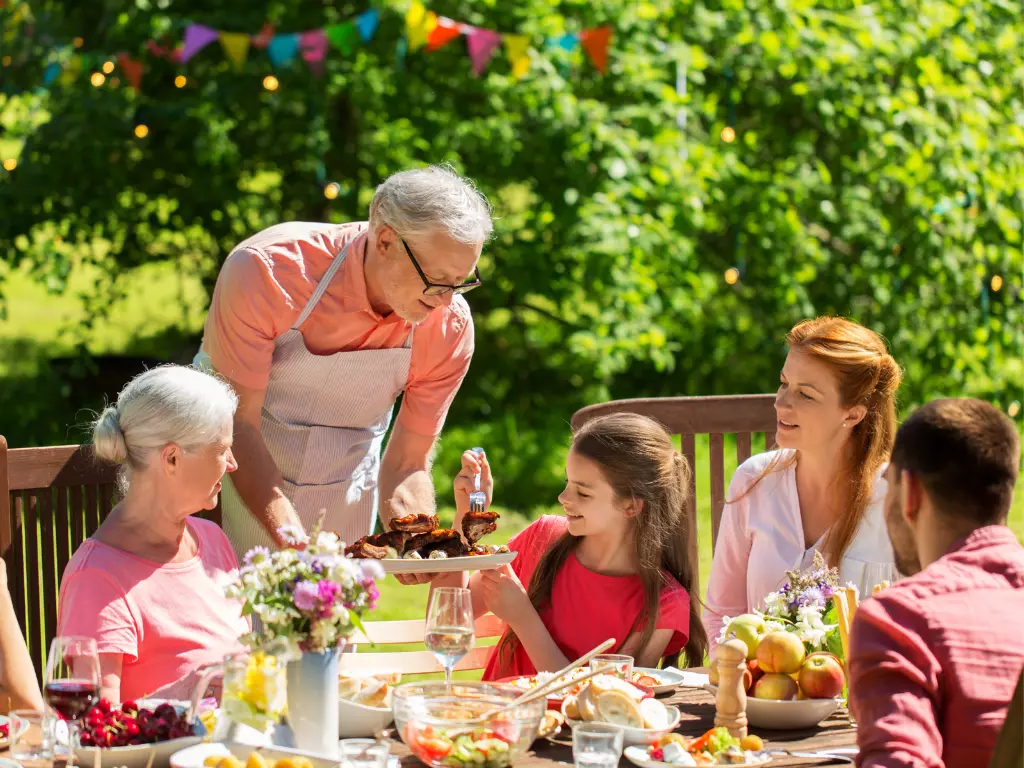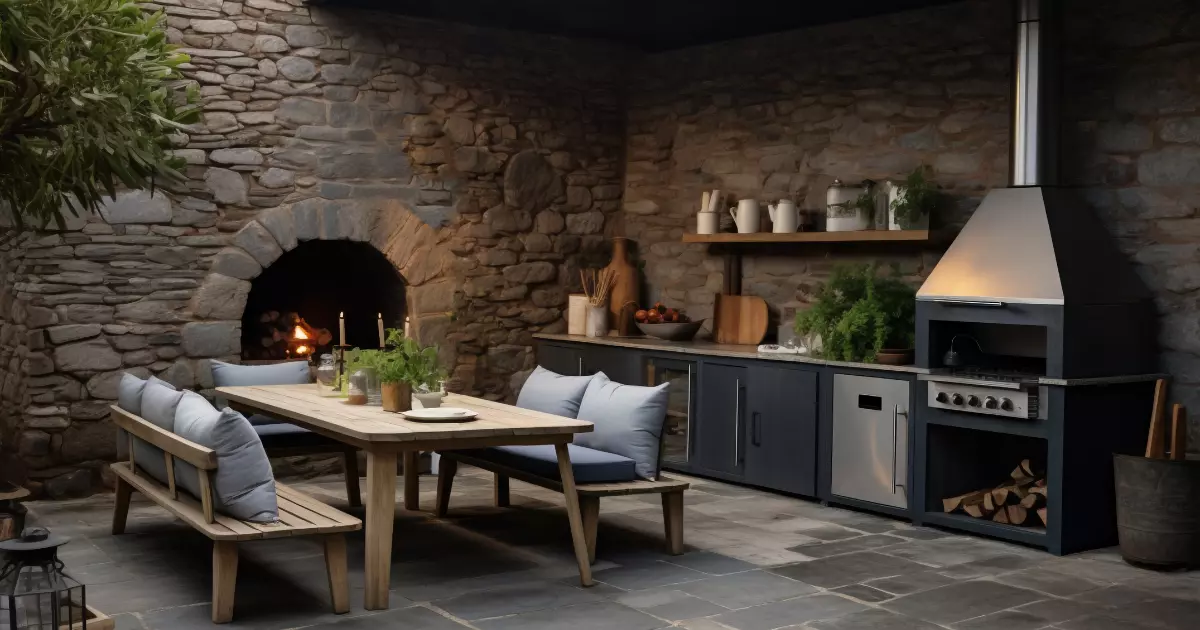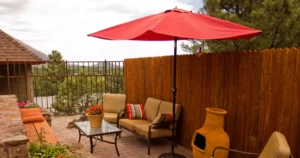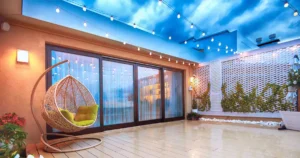That’s a good question – is an outdoor kitchen worth it? It can definitely take your backyard setup to the next level for entertaining. However, it’s definitely a big-ticket purchase. This guide aims to walk through all the important things you need to weigh to decide if building an outdoor kitchen is truly worth it for your specific situation or not. Thinking through all the pros and cons ahead of time will help you figure out if it’s really the best use of funds or if there might be better options for your backyard and lifestyle.
So, what exactly is an outdoor kitchen? Essentially, it’s an area designed for food prep, cooking, and cleanup located outside your home. It allows you to extend your cooking and entertaining spaces beyond just the indoor kitchen.
Outdoor kitchens have really taken off in the last 10 years or so as more homeowners look for ways to up their outdoor living game. But putting together a fully functional outdoor cooking setup that really has everything you need is no small investment. Most people can expect to pay somewhere in the ballpark of $10,000-$30,000 depending on factors like how big you want to go and what all you want to include.
This guide will help you evaluate if sinking that kind of cash into an outdoor kitchen is worth it given how you and your crew currently use – and plan to use in the future – your backyard space. By thoughtfully considering the ups, downs, costs, and other factors below, you’ll be able to make an informed decision on if it’s right for your needs and budget.
Is Your Family an Outdoor Entertaining Crew?

One of the biggest considerations is how actively your family uses the outdoor areas of your home for entertaining. An outdoor kitchen truly shines if you enjoy hosting large gatherings, cookouts, parties or casual meals outside on a regular basis throughout the warmer months.
If you primarily entertain inside or just use the backyard occasionally for relaxing meals with limited guests, an outdoor kitchen may not see enough action to justify the steep price tag. On average, homeowners recoup anywhere from 5-15% of their outdoor kitchen investment when selling their home — but only if it gets frequent, enthusiastic use that others will appreciate.
Regardless of how often you entertain now, also consider if you envision hosting more outdoors in upcoming years as family and friend circles change. Young families with small children likely use outdoor spaces more for casual play than sit-down meals currently. But priorities may shift as kids get older.
An outdoor kitchen grants the flexibility to prepare and cook meals seamlessly with guests outside. No more dashing in and out of the house to plate food or man the grill. Being able to cater swiftly to crowds is a huge advantage over piecemeal grilling or microwave cooking outside. Interacting freely with visitors during meal prep is a bonus many outdoor chefs appreciate.
Upsides of an Outdoor Kitchen
Beyond supporting entertaining needs, an outdoor kitchen provides some tangible added benefits worth exploring:
1. Expands Living Space Without Renovations
An outdoor kitchen effectively enlarges your usable square footage without costly interior renovations like room additions. It opens new areas to comfortably host in all seasons.
2. Adds Real Estate Value
High-quality outdoor kitchen installations that include durable materials and desirable appliances often increase a home’s market value more than many other renovations. Returns typically average 5-15% recouped at the sale.
3. Provides Cooking Convenience
Having a full outdoor cooking setup saves trips in and out of the house. No more awkwardly juggling hot pans or delicate dishes between indoor and outdoor cooking zones.
4. Year-Round Use Potential
With the option to include gas lines, electricity, and enclosures/covers, an outdoor kitchen permits cooking and gathering even in colder months that would rule out basic grilling setups.
5. Boosts Daily Living Experiences
Beyond events, many homeowners enjoy casual cooking lessons with kids, morning coffee dates with neighbors, or quiet weeknight meals outside simply because the option exists.
While the high upfront costs require serious consideration, done right an outdoor kitchen offers lifestyle perks that can increase overall home and property enjoyment for many years. Weighing such long-term impacts against the initial investment helps determine its potential worthwhileness.
Potential Drawbacks
No renovation comes without some drawbacks as well. Thoughtfully assessing these potential downsides is key to deciding if an outdoor kitchen fits realistically into your situation:
1. High Initial Cost
As mentioned earlier, a professionally installed outdoor kitchen usually runs $10,000-$30,000 depending on size and amenities. Materials, plumbing/electrical work, and labor all factor into the large price tag.
2. Ongoing Maintenance
Outdoor spaces require more upkeep than indoor areas. Elements and critters may damage uncovered surfaces over time, requiring repairs. Yearly cleaning/power washing also maintains usability.
3. Underutilization Risk
If you currently use the backyard sparingly and aren’t committed to hosting frequently long-term, it may not see enough action to justify the cost and maintenance responsibilities.
4. Limited Seasonal Use
In colder regions where outdoor use essentially shuts down by late fall, a kitchen designed solely for warm months could struggle to prove its worth versus annual costs.
Carefully considering potential drawbacks alongside intended usage helps determine if the pros truly outweigh the cons and costs for your situation long-term. Those just dabbling in casual outdoor dining may find other improvements provide better value.
Outdoor Kitchen Design Options

Before getting into costs, the first thing to think about is what kind of design would work best for you.
- Built-In vs Freestanding: While built-ins offer customization and permanence, freestanding kitchens can be moved or stored seasonally at lower upfront costs.
- Surfacing Materials: Granite, stone, and concrete provide longevity in high-use areas but cost more than faux alternatives. Wood needs more maintenance.
- Standard vs Luxury Features: Options like the sink, refrigerator, ice maker, or rotisserie add excitement but increase expenses. Focus on basics for the best value.
- Size/Layout: Plan space efficiently to fit your typical crowds and flow needs within the budgets outlined below. Expansive areas increase costs significantly.
Within each of these categories, wide ranges exist. Comparing specific estimates factors in local installers, materials availability, and any unique home/layout challenges to make an informed decision. Professional consultation helps curb budgeting surprises.
Estimated Costs to Consider
To help gauge general pricing expectations, here’s a cost breakdown for the common outdoor kitchen:
1. Main Construction Costs
When it comes to deciding if an outdoor kitchen is really worth it, one of the major things to consider up front is the costs involved in making it happen. How much you can expect to pay for building one really varies based on things like materials, amenities, and who does the work. As a general rule of thumb though, the baseline for a basic outdoor cooking setup usually falls somewhere in the range of $5,000 to $25,000 or more. Some of the biggest ticket items that will determine your overall costs include:
- Cabinets: Look for outdoor-rated cabinets made from water-resistant materials like stainless steel or aluminum. These usually run $2,000-$5,000 installed. Try to include at least two sink/counter areas.
- Countertops: Granite, quartz, or concrete formulated for outdoor use vary in price depending on material, thickness, and space. Budget $2,000-$5,000.
- Grill: A basic gas grill costs $500-$1,500, while a larger dual-fuel or infrared model is around $1,500-$3,000. Add a few hundred more for propane installation.
- Appliances: An outdoor fridge starts at $1,000 typically. A built-in outdoor oven ranges from $2,500-$5,000 depending on brand and features.
- Installation: Professional construction work like plumbing, electrical, and assembly will cost $2,000-$5,000 or more. Permits and fees may apply too.
Given your budget and plans for future use, does this initial investment seem worthwhile? Keep reading for more factors to consider in your decision.
2. Additional Features that Add Cost
While the basics of cabinetry, countertops, and appliances will get you a functional outdoor kitchen setup, there are numerous other features you may want to include that further drive up the costs:
- Room additions: Partial roof structures, pergolas or screen rooms around the kitchen area protect from sun/rain and extend usability but add $5,000-$15,000+ to the budget.
- Lighting: Built-in lighting under cabinets or overhead lighting with a lighting plan will run $500-$1,000 installed.
- Plumbing fixtures: Sinks, faucets, supply lines, and drains all need to be heavy-duty outdoor versions which are $500-$1,000 apiece.
- Tile/stone backsplashes: Budget $500-$2,000 for the material and installation of water-resistant backsplashes.
- Beverage centers: Built-in refrigerated beverage centers start around $1,500.
- Seating: Durable wicker, resin or slatted furniture suitable for outdoor use adds $500-$3,000 depending on pieces purchased.
- Flooring: Consider stone, tile, composite decking or paver options especially if not already covered – $2,000+ typically.
Some of these additional cost factors could potentially be skipped or added later, so evaluate if they’re essential right away based on your budget.
3. Maintenance Costs and Considerations
While an outdoor kitchen provides years of enjoyment, ongoing maintenance is crucial to protect your significant investment against the elements over time. Factor in at least a few hundred dollars annually for:
- Cleaning: Your outdoor appliances and surfaces will collect more grime/mildew than indoor ones, requiring more frequent scrubbing and pressure washing – plan monthly cleanings.
- Repairs: Minor issues like caulking cracks or fixing weathered surfaces may run $50-$500 depending on the repair needed. Sun/moisture can degrade materials faster outdoors.
- Touch-ups: Faded paint or stained stone may need annual touch-ups costing $50-$200 depending on materials.
- Inspections: Check gas lines and appliances annually for safety/functionality from a pro for $100-$200.
- Replacements: Parts like faucets, and cabinet/countertop surfaces may start needing replaced every 5-10 years at the original purchase costs. Moveable parts also wear out faster outside.
Factor in these ongoing maintenance costs of $500-$1,000 or more annually when considering the total long-term value of an outdoor kitchen investment. Proper care upfront also helps minimize future repair/replacement costs down the line.
Will You Recoup Costs When Selling?
ROI estimates rarely consider a home’s inherent enjoyment value beyond dollar returns at resale. Still, stats show professionally installed outdoor kitchens featuring durable, coveted equipment often add 5-15% back to a home’s sale price depending on the following factors:
- Quality of Materials and Construction – Higher-end features made from stainless steel, stone or composite materials versus lesser alternatives sell upgrades best.
- Yard Size and Layout – Spacious, private yards best showcase an outdoor space’s full potential whereas a tiny lot may not express value as well.
- Location and Demographics – Areas with warm climates and homeowners tending to favor outdoor living activities gain the greatest appreciation. Older homeowners may value updated amenities less.
- Comparable Sales/Market Trends – Sellers realize more ROI potential in favorable, appreciating housing markets versus slow or declining conditions affecting values overall.
While capital appreciation remains unpredictable, quality outdoor kitchens installed to suit modern outdoor living priorities usually enhance home values in desirable neighborhoods well beyond costs. Their worth depends on getting used and being shown off well to future buyers.
Added Value to Your Home

While the core value of an outdoor kitchen is lifestyle enhancement for your family, installing one can potentially add tangible financial value when you sell your home as well. Data from Remodeling Magazine’s annual Cost vs. Value Report shows an outdoor kitchen recoups between 64-91% of its cost on resale on average, making it one of the smartest home remodels.
Of course, the resale value gained will depend on numerous market factors, but on average you should see returns. An outdoor kitchen can also increase curb appeal and make your home’s outdoor space a more usable, functional area for entertaining.
In areas with mild climates where outdoor spaces are used year-round, outdoor kitchens have been shown to potentially increase a home’s asking price by up to 5-10% according to realtor data as well. Any added value is just another factor to consider in terms of long-term returns on the investment. Of course, an outdoor kitchen must fit within the lifestyle, budget, and culture of your region for it to be worthwhile financially versus just installation for enjoyment’s sake.
Frequently Asked Questions (FAQs)
As you’re going through the process of deciding if an outdoor kitchen is right for you, some common questions likely come to mind. It’s good to take a look at answers to a few of those frequently asked things up front as part of making your choice:
Q: Will insects/bugs be a problem?
It’s common to worry insects will infiltrate an outdoor kitchen and dining space more than normal. However, with tight-fitting screens on appliances, keeping food and surfaces covered when not in use, and cleaning up crumbs/spills regularly, you shouldn’t experience excessive bugs. You may see some typical outdoor critters like spiders or ants at times, but careful maintenance keeps it manageable.
Q: What about rainy weather?
Some features like partial roofs, pergolas, or overhangs provide coverage to continue enjoying your kitchen and dining space even in light rain or storms. Appliances also have options like infrared grills that work in many weather conditions. Just use common sense Safety when lightning could be a risk.
Q: How do I prep/cook outdoors in cold weather?
With warm layers and possibly portable heating, outdoors is still very usable even in colder temps. Gas receptacles can keep cooktops/ovens going when it’s not above freezing. Consider infrared/dual-fuel grills that transition well between seasons. Prep indoors and simply finish/plate food outside.
Wondering how to keep cooking on cold nights? Learn how smokeless fire pits work for cool weather entertainment.
Q: Can an outdoor kitchen be used year-round?
With proper planning including gas lines, electricity, durable surfaces, and optional enclosures, many outdoor kitchens can be enjoyed for 11-12 months per year. Usage may slow some in colder months but is possible with the right design features.
Q: Is maintenance very time-consuming for an outdoor kitchen?
Outdoor kitchens do require more annual maintenance compared to indoor spaces. Plan to power wash surfaces, clean grills, check appliances and address any wear and tear. Substantial repairs may be needed every 5-10 years depending on materials and usage.
Q: Will an outdoor kitchen increase my home’s value?
Studies show that high-quality outdoor kitchen installations can increase a home’s value by 5-15% on average. However, this depends on location, comparable recent sales, and whether the outdoor space effectively enhances curb appeal and livability.
Q: Is it better to have a built-in or freestanding outdoor kitchen?
There are pros and cons to both. Built-ins provide customization and permanence while freestanding models offer flexibility in arrangement and storage potential at a lower upfront cost. Consider your goals and space.







